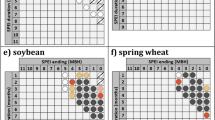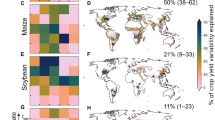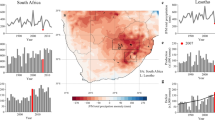Abstract
The risk of extreme climatic conditions leading to unusually low global agricultural production is exacerbated if more than one global ‘breadbasket’ is exposed at the same time. Such shocks can pose a risk to the global food system, amplifying threats to food security, and could potentially trigger other systemic risks1,2. While the possibility of climatic extremes hitting more than one breadbasket has been postulated3,4, little is known about the actual risk. Here we combine region-specific data on agricultural production with spatial statistics of climatic extremes to quantify the changing risk of low production for the major food-producing regions (breadbaskets) over time. We show an increasing risk of simultaneous failure of wheat, maize and soybean crops across the breadbaskets analysed. For rice, risks of simultaneous adverse climate conditions have decreased in the recent past, mostly owing to solar radiation changes favouring rice growth. Depending on the correlation structure between the breadbaskets, spatial dependence between climatic extremes globally can mitigate or aggravate the risks for the global food production. Our analysis can provide the basis for more efficient allocation of resources to contingency plans and/or strategic crop reserves that would enhance the resilience of the global food system.
This is a preview of subscription content, access via your institution
Access options
Access Nature and 54 other Nature Portfolio journals
Get Nature+, our best-value online-access subscription
$29.99 / 30 days
cancel any time
Subscribe to this journal
Receive 12 print issues and online access
$209.00 per year
only $17.42 per issue
Buy this article
- Purchase on Springer Link
- Instant access to full article PDF
Prices may be subject to local taxes which are calculated during checkout


Similar content being viewed by others
Data availability
Crop yield data are taken from official governmental databases: data from Argentina can be accessed at http://www.siia.gov.ar/; from Australia at https://www.abs.gov.au; from Brazil at http://www.conab.gov.br; from China at http://data.stats.gov.cn/; from Europe and the Ukraine at http://www.fao.org/faostat/en; from India at http://eands.dacnet.nic.in/; from Indonesia at https://www.bps.go.id/linkTableDinamis/view/id/865; from Russia at http://cbsd.gks.ru/ and from the United States at http://quickstats.nass.usda.gov. Climate re-analysis data used in our analysis can be accessed at http://hydrology.princeton.edu/data/pgf/.
Code availability
The R script written to read and analyse data and generate figures can be accessed at https://github.com/FranziskaGaupp/Simultaneous_BB_failure
References
Johnstone, S. & Mazo, J. Global warming and the Arab Spring. Survival 53, 11–17 (2011).
Von Braun, J. & Tadesse, G. Global Food Price Volatility and Spikes: An Overview of Costs, Causes, and Colutions Discussion Papers on Development Policy No. 161 (ZEF, 2012).
Schaffnit-Chatterjee, C., Schneider, S., Peter, M. & Mayer, T. Risk Management in Agriculture (Deutsche Bank Research, 2010).
UK–US Taskforce on Extreme Weather and Global Food System Resilience Extreme Weather and Resilience of the Global Food System Final Project Report (The Global Food Security Programme, 2015).
Lobell, D. B. & Field, C. B. Global scale climate–crop yield relationships and the impacts of recent warming. Environ. Res. Lett. 2, 014002 (2007).
Bren d’Amour, C., Wenz, L., Kalkuhl, M., Christoph Steckel, J. & Creutzig, F. Teleconnected food supply shocks. Environ. Res. Lett. 11, 035007 (2016).
Fraser, E. D. G., Simelton, E., Termansen, M., Gosling, S. N. & South, A. “Vulnerability hotspots”: integrating socio-economic and hydrological models to identify where cereal production may decline in the future due to climate change induced drought. Agric. Meteorol. 170, 195–205 (2013).
Puma, M. J., Bose, S., Chon, S. Y. & Cook, B. I. Assessing the evolving fragility of the global food system. Environ. Res. Lett. 10, 024007 (2015).
Von Braun, J. The food crisis isn’t over. Nature 456, 701–701 (2008).
Maxwell, D. & Fitzpatrick, M. The 2011 Somalia famine: context, causes, and complications. Glob. Food Secur. 1, 5–12 (2012).
Ratnam, J. V., Behera, S. K., Ratna, S. B., Rajeevan, M. & Yamagata, T. Anatomy of Indian heatwaves. Sci. Rep. 6, 24395 (2016).
Ward, P. J. et al. Strong influence of El Niño Southern Oscillation on flood risk around the world. Proc. Natl Acad. Sci. USA 111, 15659–15664 (2014).
Anderson, W. B., Seager, R., Baethgen, W., Cane, M. & You, L. Synchronous crop failures and climate-forced production variability. Sci. Adv. 5, eaaw1976 (2019).
Tigchelaar, M., Battisti, D. S., Naylor, R. L. & Ray, D. K. Future warming increases probability of globally synchronized maize production shocks. Proc. Natl Acad. Sci. USA 115, 6644–6649 (2018).
Mehrabi, Z. & Ramankutty, N. Synchronized failure of global crop production. Nat. Ecol. Evol. 3, 780–786 (2019).
Gaupp, F., Pflug, G., Hochrainer-Stigler, S., Hall, J. & Dadson, S. Dependency of crop production between global breadbaskets: a copula approach for the assessment of global and regional risk pools. Risk Anal. 37, 2212–2228 (2016).
Sarhadi, A., Ausín, M. C., Wiper, M. P., Touma, D. & Diffenbaugh, N. S. Multidimensional risk in a nonstationary climate: joint probability of increasingly severe warm and dry conditions. Sci. Adv. 4, eaau3487 (2018).
Zheng, H. F. et al. Phosphorus control as an effective strategy to adapt soybean to drought at the reproductive stage: evidence from field experiments across northeast China. Soil Use Manag. 31, 19–28 (2015).
Yin, X. G., Olesen, J. E., Wang, M., ÖztürkI. & Chen, F. Climate effects on crop yields in the northeast farming region of China during 1961–2010. J. Agric. Sci. 154, 1190–1208 (2016).
Lobell, D. B., Schlenker, W. & Costa-Roberts, J. Climate trends and global crop production since 1980. Science 333, 616–620 (2011).
Duncan, J. M. A., Dash, J. & Tompkins, E. L. Observing adaptive capacity in Indian rice production systems. AIMS Agric. Food 2, 165–182 (2017).
Fishman, R. M. Climate Change, Rainfall Variability, and Adaptation through Irrigation: Evidence from Indian Agriculture (Columbia Univ., 2011).
Tao, F., Yokozawa, M., Liu, J. & Zhang, Z. Climate–crop yield relationships at provincial scales in China and the impacts of recent climate trends. Clim. Res. 38, 83–94 (2008).
Wassmann, R. et al. Regional vulnerability of climate change impacts on Asian rice production and scope for adaptation. Adv. Agron. 102, 91–133 (2009).
Zhang, T., Zhu, J. & Wassmann, R. Responses of rice yields to recent climate change in China: an empirical assessment based on long-term observations at different spatial scales (1981–2005). Agric. Meteorol. 150, 1128–1137 (2010).
Chatham House Resource Trade Database (CHRTD) (Chatham House, 2017); https://resourcetrade.earth/data?year=2012&units=value
Rosenzweig, C. et al. Assessing agricultural risks of climate change in the 21st century in a global gridded crop model intercomparison. Proc. Natl Acad. Sci. USA 111, 3268–3273 (2014).
Stehfest, E., Heistermann, M., Priess, J. A., Ojima, D. S. & Alcamo, J. Simulation of global crop production with the ecosystem model DayCent. Ecol. Model. 209, 203–219 (2007).
Auffhammer, M., Ramanathan, V. & Vincent, J. R. Climate change, the monsoon, and rice yield in India. Climatic Change 111, 411–424 (2012).
Masutomi, Y., Takahashi, K., Harasawa, H. & Matsuoka, Y. Impact assessment of climate change on rice production in Asia in comprehensive consideration of process/parameter uncertainty in general circulation models. Agric. Ecosyst. Environ. 131, 281–291 (2009).
Avnery, S., Mauzerall, D. L., Liu, J. & Horowitz, L. W. Global crop yield reductions due to surface ozone exposure: 1. Year 2000 crop production losses and economic damage. Atmos. Environ. 45, 2284–2296 (2011).
Kersebaum, K. C. & Nendel, C. Site-specific impacts of climate change on wheat production across regions of Germany using different CO2 response functions. Eur. J. Agron. 52, 22–32 (2014).
Statistical Database (Ministerio de Agricultura, Ganaderia y Pesca de Argentina, 2015); http://www.siia.gov.ar
Crop Production Statistics (Ministry of Agriculture and Farmers Welfare, 2015); http://eands.dacnet.nic.in/
Economics, Statistics and Market Information System (USDA, 2015); http://quickstats.nass.usda.gov
Regional Data (National Bureau of Statistics of China); http://data.stats.gov.cn/
Séries Históricas (Companhia Nacional de Abastecimento Brazil, 2015); http://www.conab.gov.br
Historical Selected Agriculture Commodities (Australian Bureau of Statistics, 2015); https://www.abs.gov.au
Statistical Database (Russian Federal State Statistics Service, 2018); http://cbsd.gks.ru/
Statistical Database (Statistics Indonesia, 2018); https://www.bps.go.id/linkTableDinamis/view/id/865
FAOSTAT (FAO, 2015); http://www.fao.org/faostat/en
Sheffield, J., Goteti, G. & Wood, E. F. Development of a 50-year high-resolution global dataset of meteorological forcings for land surface modeling. J. Clim. 19, 3088–3111 (2006).
Sheffield, J., Wood, E. F. & Roderick, M. L. Little change in global drought over the past 60 years. Nature 491, 435–438 (2012).
Auffhammer, M., Ramanathan, V. & Vincent, J. R. Integrated model shows that atmospheric brown clouds and greenhouse gases have reduced rice harvests in India. Proc. Natl Acad. Sci. USA 103, 19668–19672 (2006).
Ray, D. K., Gerber, J. S., MacDonald, G. K. & West, P. C. Climate variation explains a third of global crop yield variability. Nat. Commun. 6, 5989 (2015).
Osborne, T. M. & Wheeler, T. R. Evidence for a climate signal in trends of global crop yield variability over the past 50 years. Environ. Res. Lett. 8, 024001 (2013).
Schlenker, W. & Roberts, M. J. Nonlinear temperature effects indicate severe damages to US crop yields under climate change. Proc. Natl Acad. Sci. USA 106, 15594–15598 (2009).
McKee, T. B., Doesken, N. J. & Kleist, J. The relationship of drought frequency and duration to time scales. In Proc. 8th Conference on Applied Climatology 179–184 (American Meteorological Society, 1993).
Mueller, N. D. et al. Cooling of US Midwest summer temperature extremes from cropland intensification. Nat. Clim. Change 6, 317–322 (2016).
Mueller, N. D. et al. Global relationships between cropland intensification and summer temperature extremes over the last 50 years. J. Clim. 30, 7505–7528 (2017).
Lobell, D. B. & Asseng, S. Comparing estimates of climate change impacts from process-based and statistical crop models. Environ. Res. Lett. 12, 015001 (2017).
Luo, Q. Temperature thresholds and crop production: a review. Climatic Change 109, 583–598 (2011).
Doorenbos, J. & Kassam, A. H. Yield Response to Water Irrigation and Drainage Paper No. 33 (FAO, 1979).
Shepherd, T. G. Atmospheric circulation as a source of uncertainty in climate change projections. Nat. Geosci. 7, 703–708 (2014).
Welch, J. R. et al. Rice yields in tropical/subtropical Asia exhibit large but opposing sensitivities to minimum and maximum temperatures. Proc. Natl Acad. Sci. USA 107, 14562–14567 (2010).
Burton, I. et al. 2009 UNISDR Terminology on Disaster Risk Reduction (UNISDR, 2015).
IPCC Managing the Risks of Extreme Events and Disasters to Advance Climate Change Adaptation: Special Report (eds Field, C. B. et al.) (Cambridge Univ. Press, 2012).
Richter, G. M. & Semenov, M. A. Modelling impacts of climate change on wheat yields in England and Wales: assessing drought risks. Agric. Syst. 84, 77–97 (2005).
Sklar, M. Fonctions de répartition à n dimensions et leurs marges (Université Paris, 1959).
Aas, K., Czado, C., Frigessi, A. & Bakken, H. Pair-copula constructions of multiple dependence. Insur. Math. Econ. 44, 182–198 (2009).
Kurowicka, D. & Cooke, R. M. Uncertainty Analysis with High Dimensional Dependence Modelling (Wiley, 2006).
Bedford, T. & Cooke, R. M. Vines: a new graphical model for dependent random variables. Ann. Stat. 30, 1031–1068 (2002).
Dißmann, J., Brechmann, E. C., Czado, C. & Kurowicka, D. Selecting and estimating regular vine copulae and application to financial returns. Comput. Stat. Data Anal. 59, 52–69 (2013).
Akaike, H. Information theory and an extension of the maximum likelihood principle. In Proc. 2nd International Symposium on Information Theory 2nd edn (eds Petrov, B. N. & Csáki, F.) 267–281 (Akadémiai Kiadi, 1973).
Acknowledgements
This research was supported by the International Institute for Applied Systems Analysis and the ECOCEP project, funded by the People Programme (Marie Curie Actions) of the European Union’s Seventh Framework Programme FP7-PEOPLE-2013-IRSES, grant agreement no. 609642. Part of the research by S.H.-S. received funding from the Austrian Climate Research Program (KR15AC8K12597).
Author information
Authors and Affiliations
Contributions
The analysis was conceived by F.G., J.H. and S.H.-S. and conducted by F.G. All authors contributed to writing the paper.
Corresponding author
Ethics declarations
Competing interests
The authors declare no competing interests.
Additional information
Peer review information Nature Climate Change thanks Christopher Bren d’Amour and the other, anonymous, reviewer(s) for their contribution to the peer review of this work.
Publisher’s note Springer Nature remains neutral with regard to jurisdictional claims in published maps and institutional affiliations.
Supplementary information
Supplementary Information
Supplementary Figs. 1–8, Table 1 and references.
Supplementary Data 1
Calculations of expected crop losses in case of a breadbasket failure.
Supplementary Data 2
Pearson correlation coefficient (r) between Princeton re-analysis climatological data and detrended, observed historical subnational crop yield data.
Rights and permissions
About this article
Cite this article
Gaupp, F., Hall, J., Hochrainer-Stigler, S. et al. Changing risks of simultaneous global breadbasket failure. Nat. Clim. Chang. 10, 54–57 (2020). https://doi.org/10.1038/s41558-019-0600-z
Received:
Accepted:
Published:
Issue Date:
DOI: https://doi.org/10.1038/s41558-019-0600-z
This article is cited by
-
Research progresses and prospects of multi-sphere compound extremes from the Earth System perspective
Science China Earth Sciences (2024)
-
Genome-wide transcriptional response of Escherichia coli O157:H7 to light-emitting diodes with various wavelengths
Scientific Reports (2023)
-
Contrasting area and yield responses to extreme climate contributes to climate-resilient rice production in Asia
Scientific Reports (2023)
-
Global droughts connected by linkages between drought hubs
Nature Communications (2023)
-
The optimization of model ensemble composition and size can enhance the robustness of crop yield projections
Communications Earth & Environment (2023)



